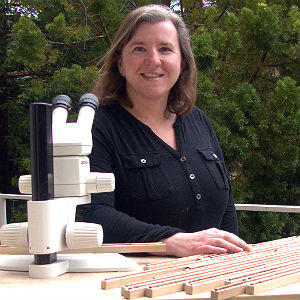 Allyson Carroll is a research associate at Humboldt State University, working on Save the Redwood League’s “Redwoods and Climate Change Initiative.”
Allyson Carroll is a research associate at Humboldt State University, working on Save the Redwood League’s “Redwoods and Climate Change Initiative.”
Allyson’s focus is dendrochronology, or the study of tree rings, and she has created the first network of redwood tree-ring series that can now be used to determine tree age as well as understand growth, climate, and fire interactions. Allyson and colleagues also aged the 1,640-year-old McApin Tree at the newly acquired Harold Richardson Redwoods Reserve along the Sonoma coast.
In this installment of Beyond the Lab, Allyson discusses her passion for coastal redwood ecosystems, and how her research in trees initially began with her work in the ocean.
What made you want to become a researcher?
My work with redwoods and tree rings initially stemmed from an interest in the ocean. I originally studied oceanography, and it was during an internship at Scripps Institute for Oceanography that I worked with cores from corals to study past conditions of the sea. I then worked at the Tree Ring Lab at Columbia University’s Lamont Doherty Earth Observatory and transferred my skills to study cores from trees. Constant through these endeavors is a love of the natural world and an interest in informing our ecological understanding of it.
What gets you going every day (besides coffee) and how do you stay motivated?
The study of tree rings can be a very tedious and labor-intensive undertaking. Essentially, I’m looking at climate-induced patterns of the ring-widths over centuries and even millennia to cross-date each sample. My motivation for taking on such a challenging task comes from the immediate desire to solve the puzzle in front of me combined with the larger-scale understanding that the resulting data will contribute to our ability to understand redwood growth and climate responses. I’m honored to work with samples from these magnificent trees, so I always want to do my best to translate what the core samples can tell us.
What limitations or challenges do you face as a researcher in your field?
The rigorous and detailed work essential for peer-reviewed research can often be overwhelming for a general audience, so it’s a challenge to find avenues to communicate our work on a broader scale. Fortunately, Save the Redwoods League does a fantastic job of sharing redwood science with the public in a way that’s easy to comprehend. One personal approach to this challenge has been to share our findings with educators and interpreters - teaching the teachers. I recently led a presentation and discussion with rangers and interpreters at Muir Woods National Monument, amplifying knowledge of our research by informing those who in turn communicate with hundreds of thousands of visitors each year.
What do you think the public should understand about scientific research, particularly in environmental conservation?
I’d encourage the public to dive deeper than simplified headlines – to understand the nuances that good scientific research reveals. There are good conduits of scientific communication out there that can be found with a little digging. Also, the process of scientific research involves an aggregation of studies on any system, so remember to take each study as a part of the whole. It’s also important to understand why redwoods are important to the environment, especially in Northern California, where the coast redwood ecosystem is dominant. The redwood forests include thousand-year-old trees that can hold massive amounts of carbon, which is just one element of their inherent value.
Also, it’s important to know that there is great skill involved in working with tree cores and gathering data sets.
The technique of cross-dating is particularly difficult for redwoods.
When I began my research in redwood dating, there were chronologies going back thousands of years for giant sequoia, but not for coast redwood. With the help of funding from Save the Redwoods League for the climate change initiative, we were finally able to gather enough information to interpret one tree, and continue that work for multiple trees and sites, eventually leading to a whole new field of research and data collection across the entire redwood landscape.
Is there someone you look up to, consider a mentor or who inspires you? Why?
Dr. Stephen Sillett leads our research team and has been a pioneer of redwood canopy biology since the 1990s. Steve has been a great mentor over the past decade, sharing his vast knowledge about redwood ecosystems. Steve leads by example with a fastidious attention to detail and precision while working with large data sets that is necessary for studying massive trees. Steve’s commitment to high caliber work during all stages – fieldwork, analysis, and writing – is a model for producing enduring, quality research contributions.
Where do you see yourself in five years?
Well, in five years my daughter will be graduating high school, so I’ll definitely be making some transitions in my personal life! Professionally, I’d love to see the redwood tree-ring chronologies expand and continue to be utilized by us and other researchers. I’d also like to continue to pursue avenues of scientific communication about redwoods.
Recently, I really enjoyed assisting with the California Academy of Sciences’ Giants of Land and Sea exhibit that include a fantastic display and interpretation of an eight-foot diameter redwood round.
What more do you want people to know about you, your team or your work?
While my research focus is redwood tree rings, I’m part of a larger team studying many aspects of redwood ecology, conservation and management. For example, my colleagues have developed equations to determine the biomass of standing redwoods and shown that redwood forests store more carbon per acre than any other forest in the world. Save the Redwoods League supports much of our research and is an organization that truly astounds me in the amount of real progress that they make protecting, managing, and studying redwoods.

Message sent
Thank you for sharing.